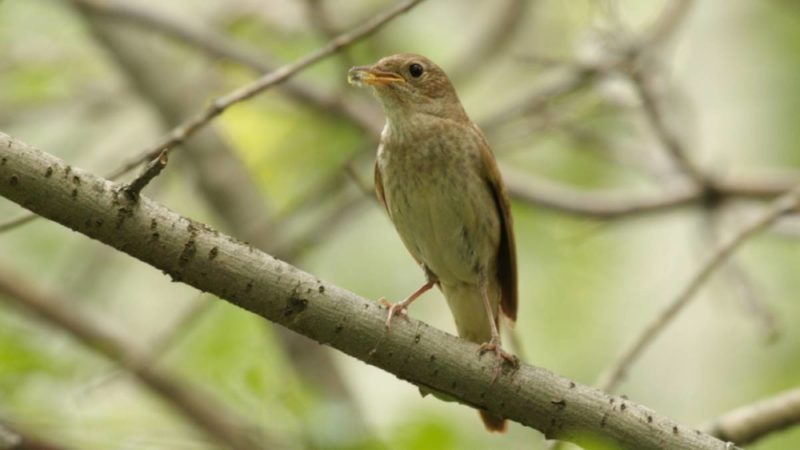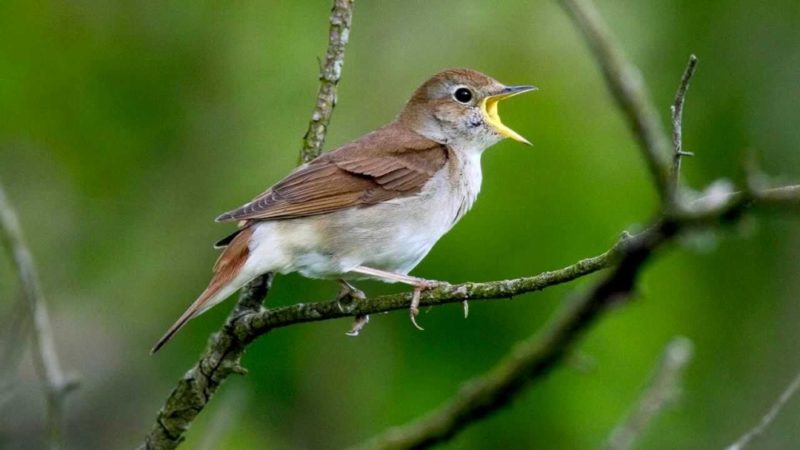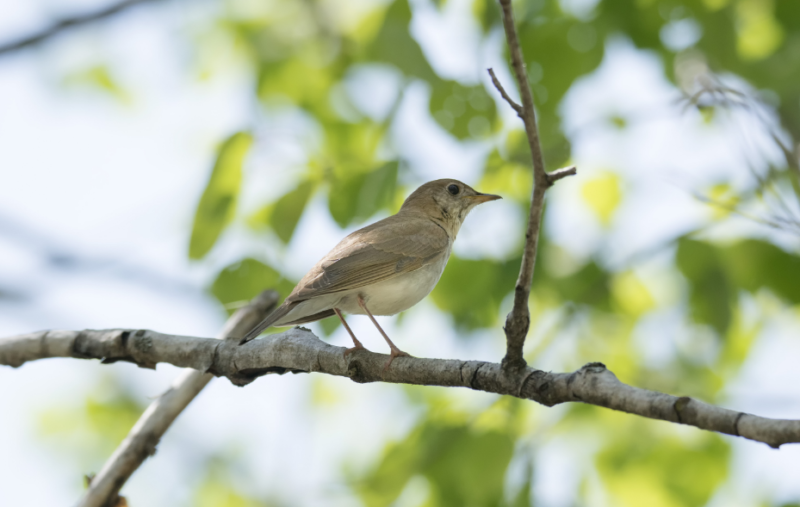The nightingale bird is a real celebrity. So many poems and songs are not dedicated to any feathered creature. The wondrous voice of this little creature informs people about spring, and if you heard bizarre trills, you know - it has come warm! Nightingale is an ordinary bird, not distinguished by its outstanding appearance, and beauty in general, but bird lovers dream of having such a pet. Consider the description of the species, learn about it all the most interesting.
Material Content:
Description and features of the species
The species belongs to the family of Mukholovs, a group of passerines. Common nightingale is more common in our country. This is a small bird weighing, on average, 25 g, and the length of his body reaches only 16 −18 cm. The color of the plumage will not attract the eyes of this songbird. The main color is olive brown, with a lighter tinge of the abdomen, it has a pattern of darker spots, and wings and tail are cast with a red. The beak is neat, small, stands out against the background of the general color in yellow.
Other types of nightingale:
- South or West. This bird is very similar to the nightingale, but it will give the appearance of a lack of a pattern on the abdomen. Feathered in size with a sparrow, the color of the plumage is the same as described above.
- Krasnosheyka. The main advantage of creation is a red spot on the neck, but only males have one. Females do not stand out, the plumage of a species of the same color as that of an ordinary nightingale, only the breast is lighter.
- Red-chested Nightingale. A very remarkable representative of the species, but it is impossible to meet it in our latitudes, since the handsome man lives in the Himalayas, Myanmar, China, in India and in Bhutan.The bird is blue and the breast can range from light orange to bright red.
- The nightingale is blue. Males differ in color: the feathers on the back and wings are blue-black, the breast is gray with mother of pearl, the cheeks are black, like the beak. Females are similar to the ordinary species, but some representatives have a blue shade of feathers on the back and wings.
In size, males are indistinguishable from females. An ordinary nightingale will be distinguished by gender only by an experienced ornithologist. Other species need to be watched by plumage - in the male half it is brighter.
Habitat
The distribution range of the nightingale is extensive. You can hear birds singing throughout Europe, in Western Asia (up to the Yenisei). Wintering of birds takes place in Africa.
Nightingales prefer to settle in dense thickets of shrubs located closer to water bodies. Nests of these birds are also found in the zone of deciduous forests - on the fringes, lit by the sun.
If in the park and the garden the nightingale noticed a place suitable for nesting, then he will not refuse it. Therefore, singing can be heard not only in the forest, but also in the city center. So, for example, the Kursk nightingale has established itself as an excellent city singer. It is found in city parks, and trills cannot be confused with anything, because this bird can perform up to 40 knees (ordinary nightingale trills - from 12 to 24, rarely more), which is inherent only to this species. The news of the Kursk songbird spread throughout the world in the distant imperial times, when merchants from all over the world organized fairs in the main squares. The rich nightingale ordered a nightingale for herself, and soon the singer was distributed in many countries.
As for the content in captivity, it is possible. But the nightingale, caught in nature, is difficult to adapt to new conditions.
If the bird begins to beat in the cage, it must be curtained with a dense tissue through which light does not penetrate. It is not worth disturbing a feathered bird until it calms down. At home, the nightingale can live up to 5 years. In a natural habitat, life expectancy reaches 12 years, so you should think carefully before getting yourself such a pet - it is better to sing in the wild, if the conditions are suitable for him.
Choose a spacious cage, equip a drinking bowl, feeding trough, perch, toys and a house in which the bird will hide.
Nutrition and habits
The nightingale eats mostly insects. He loves caterpillars, bugs, crickets, worms, mollusks. Ptah is very demanding on the diet of insects, and when keeping it at home, you need to try to get fresh flies and worms. In summer and autumn, the nightingale supplements the main menu with berries and fruits. You can pamper your pet with apples, raspberries and strawberries, vegetables, but insects should still be the basis.
The habits of the wild nightingale are the same as those of other birds. He tries to hide, not to catch the eye of people. If you are very lucky, then in the forest you can notice this inconspicuous bird, which, when you start to sing, forgets about the safety rules.
During the mating season, nightingale singing is more colorful, because the males compete among themselves with creativity, attracting ladies.
When the female chose her hero, he begins to flap his wings, courting the bride, and thereby showing the other singers that now it is his woman and territory.
Females play a crucial role in the arrangement of life. While the husband sings, the hardworking spouse and the nest advises, and lay eggs. The nest can be located both on the ground and in the branches of shrubs, but not higher than one and a half meters from the surface. The place should be safe, where predators will not find eggs, but also one from where you can observe the territory. Building a house is a real masterpiece. The nest comes out in a cup-shaped form (such as we used to see it in children's books), consists of twigs, moss, and dry leaves. Birds cover the bottom of the shelter with blades of grass and thin young branches of shrubs.
When the house is ready, the female lays eggs (from 4 to 6 pieces), they are small, only 2 cm in diameter, painted in olive brown. Young people are born in 15 days (on average).
Daddies do not take part in building a house and hatching eggs, they sing all this time. But when the chicks hatch, the male becomes silent so as not to draw outside attention to the nest with his voice. From this moment, both parents already care about the offspring, drag insects to the kids, teach everything that they know.
After about 2 weeks, the chicks can fly out of the nest, they are independent, but their parents continue to help them get food. At the end of summer, the whole family begins to prepare for a long journey - a flight to winter in warmer regions.
How the bird of the flycatcher family sings
Nightingale can be heard from mid-May, it is at this time of year that the migratory bird returns to its native land, and with its song notifies people about the arrival of true spring. Only males sing, they are the first to fly home and begin to prepare for the arrival of females.
Many believe that the birds are activated at night, when the earth plunges into twilight. But this is an erroneous opinion. Nightingales sing at any time of the day or night, but in the daytime they simply cannot be heard because of the hum of cars, the singing of other birds. Therefore, lovers of listening to the nightingale trills go to the forest for “concerts” just after dark, and having heard them once, they never forget again.
Nightingale singing cannot be compared with what other birds perform. Here you will hear a melodic whistle intertwined with a click. The song consists of repeating elements, which can be from 12 to 40.
Ordinary nightingales sing most colorful, other kinds also sing songs, but not so beautiful.
Nightingale - migratory or wintering bird
Nightingale is a migratory bird if it lives in regions with severe winters. From mid-August, the birds begin to gather on a path that lies through the seas and mountains to Africa. Here the birds stay until spring, and by mid-May they get home.
But if the nightingale lives in the southern regions, where there is no food problem in the winter, then it becomes wintering, it does not need to move into the unknown from its place of residence.
Interesting Facts
Amazing creations for many hundreds of years have attracted the attention of poets and composers, thousands of songs, poems and legends are composed of them.
We also told a lot about nightingales, but we will dwell separately on other interesting facts about the bird:
- In Hungary, the remains of a nightingale were found, which, according to preliminary estimates, is more than 12 million years old. And over the centuries of its existence, the species has not changed much.
- Nightingale is a small, but high-speed bird. It can develop a flight speed of up to 50 km / h.
- The chicks leave the nest at the age of several weeks, but at the end of their life they keep in touch with their parents. Youngsters consider their ancestors more skillful in any business, and learns from them all their lives, imitates.
- Upon arrival at home, the nightingale does not begin to sing immediately, he is silent for about a week. So he rests from a long journey, goes through acclimatization.
- Nightingales always return to their nests after having left them for the winter. Young birds that flew to the warmer climes from their parental nest build their houses next to those in which they hatched.
- In the 19th century, nightingales were banned in many Russian provinces, and the fact is that the population began to decrease significantly due to the demand abroad for songbirds. People liked the songs so much that they bought birds for a lot of money, and there were a lot of hunters for them.
- A museum dedicated to nightingales is popular in Kursk.
- Every self-respecting oriental rich man had in his palace a golden cage with a nightingale. In ancient times, it was believed that the trills of this bird attract wealth and success.
- Nightingale is not only an amazing singer, but also a delicacy of world gastronomy. They eat not only the meat itself, but also the reeds.
- The nightingale's singing volume is 50 dB, so in a quiet time of the day the trill spreads for many kilometers.
- During singing, males spend a lot of energy, and you need to compensate for it with food. Thus, in order to compensate for the expended energy, the bird needs to eat feed per day based on the weight of 80% of the weight of the bird.
- And the nightingale is a natural healer. It eats insects and larvae that damage trees.
We learned that the nightingale's singing is the luring of a female, the notification of other individuals about employment, but not entertainment for people. Despite the fact that in the cage the bird will also sing, this does not compare at all with the trill that is heard from free birds. Do not catch nightingales for home maintenance, it is better to go for walks in the forest, and there enjoy the sounds of nature. In captivity, the bird will live only a third of its measured life, and this is a good reason to leave the nightingale in the forest.

















